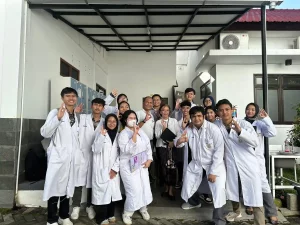Many therapies to treat cancer through chemotherapeutic medicines have been developed, such as cyclophosphamide, methotrexate, doxorubicin, and fluorouracil. Regardless, as a side effect of the chemotherapeutic drug, this treatment affected normal tissue, resulting in inappropriate drug distribution and rapid metabolism before reaching the targeted tumor tissue. Chemotherapy is a clinical technique that offers a therapeutic principle to suppress tumor metastasis, but the usage is not directly distributed among different societies due to high treatment costs, significant individual variations, and large side effects. Thermal therapy has several advantages for cancer patients, including reduced scarring, pain, time, and expense.
Obtaining proper temperature distribution is crucial in assessing the heating power of cancer cells while avoiding damage to adjacent tissue. Radiofrequency, laser thermotherapy, phototherapy, and microwave ablation are some of the heat treatment procedures used in medicine. Other than surgery and chemotherapy, laser ablation is a non-invasive tumor treatment that uses photothermal interaction between the laser and the tissue to cause minimal damage to healthy tissue .This study focuses on developing a novel multipurpose nanostructure for cancer therapy combining photodynamic therapy (PDT), photothermal therapy (PTT), and chemodynamic therapy (CDT). The researchers synthesized and characterized gold-manganese dioxide (Au-MnO2) nanostructures as photosensitive agents for these therapeutic approaches.
Traditional cancer treatments like chemotherapy often have significant side effects and limitations. Newer approaches like PDT, PTT, and CDT offer potential advantages in terms of specificity and reduced harm to healthy tissues. PDT uses photosensitizers to generate reactive oxygen species (ROS) to kill cancer cells when exposed to light. PTT employs photothermal agents that convert light energy to heat to destroy tumors. CDT catalyzes intracellular hydrogen peroxide to produce toxic ROS. The researchers aimed to combine these modalities into a single nanoplatform using gold nanoparticles for their optical properties and manganese dioxide for its ability to generate ROS. This integrated approach could potentially enhance therapeutic efficacy while minimizing side effects.
Synthesis and Characterization of Au-MnO2 Nanostructures. The Au-MnO2 nanostructures were synthesized through a two-step process: 1.) Gold nanoparticles were prepared by reducing chloroauric acid with sodium citrate. 2.) Manganese dioxide was grown on the gold nanoparticle surface by reacting potassium permanganate with the citrate-coated gold nanoparticles.
The resulting nanostructures were characterized using several techniques: 1) Transmission electron microscopy (TEM) showed spherical particles with an average diameter of 16.5 nm. 2) Dynamic light scattering (DLS) measured an average size distribution of 58.54 nm. 3) UV-Vis spectroscopy revealed a characteristic absorption peak at 438 nm. 4) X-ray diffraction (XRD) confirmed the crystalline structure of both gold and manganese dioxide components. 5) Fourier-transform infrared spectroscopy (FTIR) identified key chemical bonds. 6) X-ray photoelectron spectroscopy (XPS) verified the elemental composition.
These analyses confirmed the successful synthesis of Au-MnO2 nanostructures with the desired morphology and composition.
The PDT capabilities of the Au-MnO2 nanostructures were evaluated by measuring ROS generation under 808 nm laser irradiation. Using 1,4-diphenyl-2,3-benzofuran (DPBF) as a ROS-sensitive probe molecule, the researchers observed a decrease in DPBF absorption at 416 nm over time, indicating ROS production. The results showed that the Au-MnO2 nanostructures could effectively generate ROS when exposed to near-infrared light, demonstrating their potential as PDT agents. The manganese component likely enhanced ROS production compared to gold nanoparticles alone.
PTT performance
The PTT performance was assessed by measuring temperature changes under laser irradiation; (1) Different laser wavelengths (532 nm, 671 nm, 808 nm) were tested, with 808 nm producing the highest temperature increase. (2) At 1000 ppm concentration and 808 nm irradiation, the Au-MnO2 solution reached 66.4°C after 10 minutes. (3)The photothermal conversion efficiency was calculated to be 83% at 808 nm. (4) Temperature increases were concentration-dependent, with higher concentrations producing greater heating.
These results indicate excellent photothermal properties, making the Au-MnO2 nanostructures promising PTT agents.
The CDT capabilities were evaluated using a tetramethylbenzidine (TMB) assay to detect hydroxyl radical generation: (1) The Au-MnO2 nanostructures catalyzed the oxidation of TMB in the presence of H2O2, indicating hydroxyl radical production. (2) The reaction was time-dependent and affected by H2O2 concentration and pH.
The peroxidase-like activity of the nanostructures enables them to generate toxic ROS from endogenous H2O2 in tumor environments. This demonstrates the potential of Au-MnO2 nanostructures as CDT agents for cancer treatment.
Cytotoxicity and therapeutic efficacy were evaluated using cell culture experiments, including Cytotoxicity assays with human fibroblast (HFB) and breast cancer (MCF7) cells showed >80% viability at concentrations up to 500 μg/mL, indicating good biocompatibility; Photothermal treatment of HeLa cervical cancer cells with Au-MnO2 nanostructures and 808 nm laser irradiation reduced cell viability to 38.12% at 500 μg/mL concentration. These results suggest the Au-MnO2 nanostructures are safe at therapeutic doses and can effectively kill cancer cells when activated by near-infrared light.
Conclusion
Au-MnO2 nanostructures have been successfully constructed and produced as novel multipurpose photosensitive agents for PDT, PTT, and CDT. Under 808 nm laser irradiation, the Au-MnO2 nanostructure has demonstrated the ability to generate ROS for PDT efficiently. ROS generation was also boosted upon PTT, reaching 66.4°C. In addition, coupling the Mn metal ion of the Au-MnO2 nanostructure with the H2O2 reagent generates a •OH radical to generate oxidized TMB, which exhibits CDT properties. The biocompability evaluation using HeLa cancer cell and HFB normal cell confirmed the viability of bothe cells were consistently greater than 80% with varied concentrations of Au-MnO2 nanostructures up to 500 μg/mL concentrations. Overall, the spherical Au-MnO2 nanostructures could be a promising strategy to eliminate cancer cells by PDT, PTT, and CDT.
Link : https://pubs.rsc.org/en/Content/ArticleLanding/2024/DT/D4DT01123F









